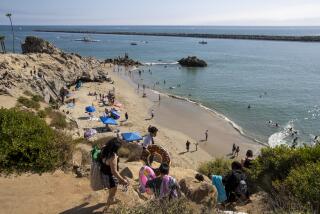Beach SOS: ‘Save Our Sand’
Walk the shore in Huntington Beach or San Clemente and the shifting sands beneath your feet are part of a beach erosion problem in Orange County.
The battle of the federal budget this year has included skirmishes over rebuilding the beaches across the country. The Bush administration wants to limit such beach-restoration projects. But last month House members disagreed and added more than $62 million for projects. They also backed the current formula in which the federal government pays 65% of a project’s construction cost, and state and local governments pick up the rest.
A month before the House vote, Orange County supervisors unanimously passed a resolution calling for maintenance of the current funding. The Bush administration wanted to cut the federal government’s share to 35%.
While the argument in Washington is about dollars, there is no quarrel that some of our important local beaches need to be rebuilt.
In San Clemente, 20 years of constant Pacific pounding has reduced the width of the beach by half. It has sucked the sand out from beneath the marine safety building used by lifeguards. Once it rested on the sand; now the foundation pilings are uncovered. There is a sea wall that prevents more sand from slipping away, but one group, the Surfrider Foundation, considers beach “armoring” like sea walls and breakwaters to be the problem, not the solution, because the structures deprive beaches of natural sand replenishment and can impede public access along the shore.
That objection is one that will have to be considered as part of the long-overdue look at the state’s policies on coastal erosion. The California Resources Agency is examining the problem and possible remedies. It recently has drawn up a draft policy that stresses the need for getting various agencies with waterfront jurisdiction to work together better. The agency is correct that it is important to look at the entire coastline and to seek cooperation among federal, state and local governments. That illustrates the need to go beyond stopgap measures done in isolated instances. In such cases, sand is replaced on one beach without understanding what’s happening on the adjacent shore. Boundary lines between counties and cities may look good on a map but don’t always mean much at the water’s edge.
Researchers say the coastal counties in the state make up only about one-quarter of the total land area, yet are home to about 80% of the population. As the merchants of Newport Beach, Laguna Beach and other communities along the coast also know, the beaches are an essential component of the economy. One survey found that direct spending at beaches for tourism and recreation amounted to over $14 billion to the state’s economy in 1998.
San Clemente officials say that although a rusting sea wall prevents sand from slipping away, it’s not a cure-all. The marine safety building and other beach structures may have to be moved inland to avoid being washed out to sea. Or more sea walls will have to be installed. Or tons of new sand will have to be put on the beach.
Moving the buildings would mean relocating them across railroad tracks. That’s a bad idea. The fewer people who need to cross the tracks, the better. Sea walls have been replaced before, and rust is a recurring problem. The best solution remains putting new sand over old, but it’s expensive. San Clemente estimates it would cost about $5 million and would only last a few years.
Orange County’s beaches are important for quality of life as well as the economy. A day at the beach does wonders to rejuvenate residents. Whether one is swimming or standing on the sand to watch dolphins and sailboats, the shoreline is an asset. While it is looking at local beach erosion, the state resources agency should consider a combination of solutions to protect the beach, ensuring first that new structures are not built in hazardous areas and that sea walls and other “hard structures” are built only as a last resort.
More to Read
Sign up for Essential California
The most important California stories and recommendations in your inbox every morning.
You may occasionally receive promotional content from the Los Angeles Times.










